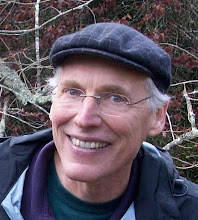I landed for a brief stay back in Austin, the city of my birth and the seat of my clan, diminished as it now is (the clan, not the city). This was my third visit there since moving away three years earlier. Emerging from the air terminal, I was confronted by the humid warmth. Even though it was mid-February, I had expected this; the resilient heat cannot be long held back by any cold front. However, I did not expect to be struck by the color of winter in Austin. It is browner than what I have become accustomed to in Oregon's wet Willamette Valley. Austin's lawns and fields were parched, the trees mostly bare. One might expect winter in a higher latitude to be more bleak than that of Central Texas, but our Pacific Northwest pine trees and continual drizzle seem to keep more green on the landscape throughout the cold season.
Austin is a big sprawling city -- growing fast, the greater metropolitan area now approaching two million. Alert for familiar sights, sounds, and smells, I walked the trash-strewn streets and breathed the vehicle exhaust, reeking of thwarted desires. I found the dusty shops filled with toxic sweets and wrappers ready to be discarded. I noticed these things readily, but they are everywhere in this world; they are not unique to Austin. I was seeking indicators that for me would render the locale distinctive. Every city wants to be known as different, weird in its own special way, but it seems that the harder the inhabitants strive for uniqueness, the more alike their cities become. For me, Austin's vaunted music scene is the same as a hundred others. Its beloved weirdness is but human nature running its peculiar but predictable course in these confusing but media-unified times and has nothing to do with the specialness of place. Across the nation, the neon insignias of commercialized regionalism all look alike. So I sought more subtle cues, unintentional signals that trigger the senses but not necessarily the frontal cortex, indicators not devised with the tourist industry or commerce in mind, unlauded accidents of place.
And I found some of these indicators. The grackles I have always admired and enjoyed for their raucous ways and sheer great numbers. In my northern home, I yearn for their sound more than for any band or singer of that live music capital. And other birds caught my attention with their once-familiar notes; the contentious piping of the mockingbird and the plaintive call of the mourning dove are distinctive reminders of my former home. The whirring plaints of the cicadas are silent during winter months, but I imagined I heard them through the roar of traffic.
And something in the air caught my attention, a subtle aroma. So faintly did it register that I hesitate to call it a smell. Yet I was continually sensitized by it. Something slightly sour, something damp, it was a constant presence as I strolled the downtown streets, especially during the first couple of days of my visit, before I became habituated. I thought of bat guano, but was not satisfied that that was the only ingredient. I walked into Pease Park, away from the confines of the bats, and the smell persisted. There beside the soft stone banks of Shoal Creek I recognized what it was: limestone. In Austin, the mineral is all about -- in building façades; in walkways, walls, and fences; and under the shallow soil. In the park limestone outcroppings dominate the hillsides and creek banks. The mild acids in the water and humid air must react with the soft stone's alkalinity to produce the pungency that calls me back. Whatever the precise mix of aromas (perhaps accompanied by certain light, barometric, aural, and visual cues), the sensation was here particularly strong. In the part of Oregon where I live, the soil is acidic and duffed with pine needles, different from that of Austin, and not associated with a long personal history.
In the park, I found a secluded spot and took a leak. My stream of piss splashed against the stone and gave forth a confirmation of my hypothesis. This was a smell I knew from distant childhood. My grandfather's used car lot on Red River Street had been carved out of a soft sedimentary hillside. As a child I played there, peeing freely against the cliff behind the back row of cars. The smell was not particularly pleasant, yet for me evocative, though in a vague way. Memories of memories of memories.
Tuesday, March 1, 2011
Subscribe to:
Comments (Atom)

